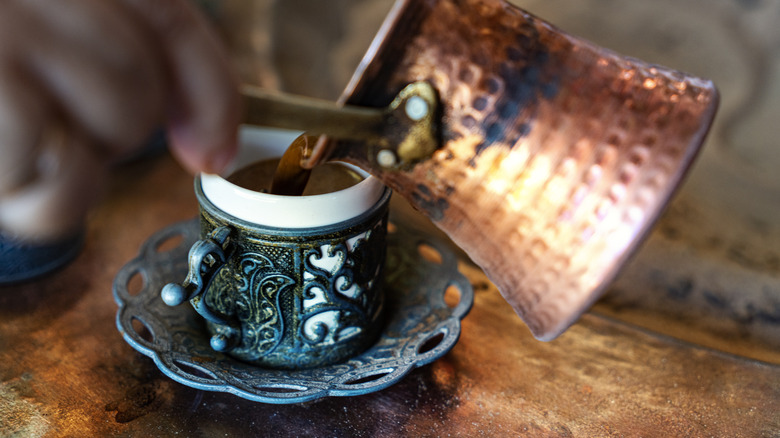The Only Way You Should Be Adding Foam To Turkish Coffee
Achieving Turkish coffee foam is all about technique. The coffee itself is made from ultra-fine coffee grounds with an almost powder-like consistency, which is responsible for the fact that Turkish coffee doesn't have to be filtered, like matcha. Instead, the fine grounds sink to the bottom of the cup for a few minutes before serving, and the foam rises to the top — that is, if you do it properly.
To do it, remove the copper teapot (aka the "cezve") from the heat just before the coffee reaches a boil. Roast over medium heat, and resist the urge to crank up the heat and scorch the batch. Low and slow is the name of the game here, and it'll take seven to 10 minutes to brew.
Then, in the same way that you might when creating latte art, gently spoon the foam from the cezve into demitasse-sized porcelain cups (aka "finjans"), then return the cezve to the stove to continue brewing. Once it's reached the desired temperature, slowly pour the coffee down the side of the finjan so as not to disturb the foam, which will rise to the top as the cup fills with denser coffee.
Slow and steady wins the race
Turkish coffee is richer and thicker than regular drip coffee, and its dissolved-grounds brewing makes for a more viscous mouthfeel and robust flavor. Typically, Turkish coffee is made from dark roast Arabica beans; some fans compare the taste to espresso.
It's a unique treat, and more accessible than it might at first seem. For apartment and dorm-dwelling foodies, a Bunsen burner or hotplate will work as a heat source instead of a stovetop. A small porcelain teapot will also get the job done in place of a cezve.
If you find that your foam really just isn't setting up, it may be because of a few reasons. One is that the coffee grinds may not be the perfect fine consistency, or two, it's possible the beans are past their due date, so be sure to use fresh ones. Lastly, the proportion of coffee to water may need to be adjusted — remember that 1 gram of coffee to 9 milliliters of water is the way to go.

